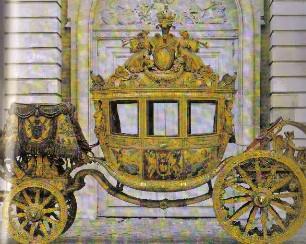Ayn Rand's The Fountainhead was one of the first books that I read because I wanted to, unassociated with any kind of school assignment. The protagonist, Roark, is an architect--a visionary, rogue, Avant-garde, etc., and as such has a hard time getting commissions. The following discussion with a prospective client begins on page 164:
"Mr. Janss, when you buy an automobile, you don't want it to have rose garlands about the windows, a lion on each fender and an angel sitting on the roof. Why don't you?"
"That would be silly," stated Mr. Janss.
"Why would it be silly? Now I think it would be beautiful. Besides, Louis the Fourteenth had a carriage like that and what was good enough for Louis is good enough for us. We shouldn't go in for rash innovations and we shouldn't break with tradition."
"Now you know damn well you don't believe anything of the sort!"
"I know I don't. But that's what you believe, isn't it? . . . Tell me, Mr. Janss, do you really think that Greek columns and fruit baskets are beautiful on a modern, steel office building?"
Just so that we are all on the same page, here is a carriage not unlike the one Roark describes.

Angels, garland, and lions were a great way to soup up your wheels anywhere between 1700 and 1830. At the time The Fountainhead was written (1946), the best ride around was probably a Bentley like this one.

And today, you know you’ve arrived if you have a playstation, flat screens, and at least one hydraulic powered flip out thingy in your car.
The discussion in Rand's book has stuck with me ever since I first read it, mostly because it has applicability to about 12 different art topics. Whenever one of them comes up this passage pops into my head. Today, I'll limit the discussion to taste. Simply put, taste, aesthetics, beauty, and so on change. It is very tempting to believe that there is a universal beauty out there that touches the soul of every man and woman on earth. When I encounter something of immense beauty I can scarcely comprehend that any one else wouldn't feel what I do. But there always are people out there who don't. Universal aesthetic appeal is a myth.* While this may be disappointing, it opens up worlds of fascinating inquiry into why we like what we do.
*I can think of two possible exceptions to this rather fatalistic pronouncement: nature and children. But people don't design those things. They just come beautiful without help, which is different. And I regretfully speculate that their appeal isn't universal, though I wish it was.

1 comment:
I own this book, but didn't get a chance to read it before I lent it out and disbefriended the person I lent it to. One day!
Post a Comment